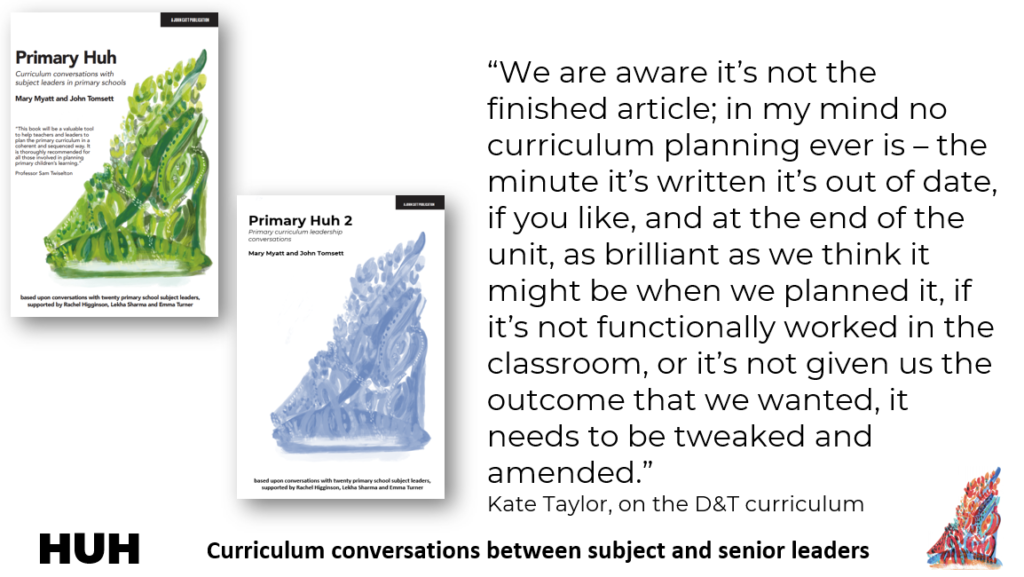
Collaborating with Mary Myatt on our Huh project has been a blast! Our new book, Primary Huh, was signed off this week. It is a moment of unadulterated relief when the copy editor says we’re finished and we can send the text off for printing. The sunshine makes it all just that little bit sweeter.
Interviewing over thirty primary colleagues was a revelatory joy. Our primary colleagues, Rachel Higginson, Lekha Sharma and Emma Turner have been tremendous co-interviewers, using their expertise to ask the nuanced primary-specific questions Mary and I might have missed.
We ended up with an excess of precious material, to the point where Primary Huh is the first of two books on primary curriculum development. Primary Huh focuses upon the individual subjects. Primary Huh 2, which will be a slightly slimmer volume and will be published in June, considers other complex issues such as the role of assessment in primary curriculum design, designing a curriculum for mixed-aged classes, designing the primary phase of a through-school curriculum, and the like.
One of the current debates around primary curriculum design concerns the secondaryisation of the primary curriculum – aka, teaching primary pupils each subject discretely, as we do in secondary. We worried that Primary Huh, with a chapter to each national curriculum subject, would be seen as a tacit approval of the secondaryisation approach to primary curriculum design. If you read the chapters, however, you’ll find subject experts extolling the virtues of their discipline, within the context of the whole interconnected primary curriculum. On the evidence of the thoughts of these subject leaders, the secondaryisation vs interconnected curriculum debate appears to be a false dichotomy. Indeed, this, from Nick Hart in his foreword to Primary Huh 2, articulates beautifully the tension between the subject disciplines, the interconnected primary curriculum and the development stage of the child:
“Within KS2 I think there is definitely scope to introduce children to subject-specific ways of thinking – to learn about how experts in a field might communicate or might think. I think it’s less clear in KS1. I think KS1 is about introducing children to the idea of different subjects, and supporting them conceptually, rather than with the discipline. What I mean by that is that in KS2, we might teach children some of the disciplinary knowledge, say in history, of analysing sources, or constructing their own accounts of events, but with infant age children, it’s more conceptual understanding of, say, what evidence is, through use of photos or paintings. I think there is a necessarily different approach in KS1 than there is in KS2 because of the stage of development of children. We separate out what’s appropriate for the different age groups. I’m not sure that what children are able to grasp at certain stages is fully appreciated, and we must guard against trying to force material that is too sophisticated on the children too soon. That said, they are able to cope with some quite big ideas as well, so it’s that balance of not dumbing down for them.”
So, Primary HUH is done and Primary Huh 2 is nearly finished. They provide a platform for the expert ideas of some tremendous primary colleagues, and I am as proud of this work as I am of anything I have done in education. This, from Professor Philippa Cordingley’s Foreword to Primary Huh, gives you a sense of the golden nuggets you’ll find between the two books’ covers:
"I began writing this foreword thinking I would garner a few choice quotations from the book to begin and end with – but the document I created had reached three pages after reading only the first four sections! That clearly wouldn’t do; every section is worthy of its place and needs reading in full. But not, I think linearly. In the end, what I treasure about Primary Huh is the way each section begins with passion and clarity about why learning in that arena matters – not just to society but also to our pupils and the communities served by our schools. I value, too, the way we can find the anatomy of the curriculum explored carefully and systematically through similar questions, so that we can read our way through how expert practitioners leading different subjects approach related questions. Last but by no means least, I deeply appreciate the voice this book gives to primary expertise. Like the god Huh, this is a never-ending book in that we can learn our way through it cyclically, coming back in each succeeding wave of Bruner’s spiral, to how an expert and deeply reflective school leader sets out to make the whole coherent, meaningful and purposeful; not least by recognising, developing and weaving together the skills and expertise of the school’s teachers. Indeed, Primary Huh surely exemplifies Lawrence Stenhouse’s claim that curriculum development relies, primarily, upon the expertise of our teachers, whose enquiring voices ring clear and true throughout this book."
The next book is SEND Huh - new contributors welcome!
